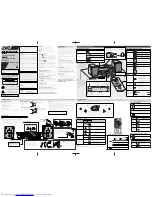
8. FINAL EQUALIZER ADJUSTMENTS:
Once the RE 27 is all “greened out”, you’re done with the pink noise
alignment test. Now the speakers are properly coupled to the specific room and the overall system response is accurately
aligned. This alone will make a great improvement in most systems, but
don’t stop at flat
necessarily. Now that the RE 27
has given you a consistent starting point, feel free to make further slider adjustments during the performance or sound check
to enhance overall sound quality. Fatten the bass, smoothen the mids or sweeten the highs to taste. You will probably find
that these adjustments will be consistently set above or below the pink noise test settings the same amount at each perfor-
mance; make a note of these further adjustments to save future tweaking during performances. For example, you note the
pink noise settings and find later that you like to have 3 dB more boost at 63 Hz for more low-end punch during the perfor-
mance. Next time, green out the analyzer during the pink noise test (get all LEDs green before making any further adjust-
ment), then immediately bump up the 63 Hz slider 3 dB as indicated by the front panel calibrations so that you’re tuned up
before the show starts (slick, no?). The constant-Q sliders will assure accurate adjustments from any slider position.
9. USING THE RANE ANALYZER WITH OTHER EQUALIZER CHANNELS:
The analyzer section of the RE 27
will respond to whatever program the test microphone picks up. Therefore, the display can be used to adjust any equalizer
channel which controls the pink noise through the speaker(s). Simply run pink noise through the desired equalizer and use
the analyzer/microphone combination to adjust that equalizer.
10. MONITORING PROGRAM MATERIAL FOR FEEDBACK USING THE DISPLAY:
Once the pink noise test is
completed, switch off the Pink Noise on the RE 27 and unplug the Rane test microphone from the front panel jack. When the
mic is unplugged, the display is automatically switched to monitor the output of the equalizer section. Adjust the RTA
LEVEL control so that an occasional green LED blinks on during the performance peaks, but no red LEDs come on: you
should be in the ±3 dB mode on the display. If feedback occurs, one or more red LEDs will light showing the genera1 feed-
back frequency area. Usually several red LEDs will be lit by the time you quickly cut back volume to kill the feedback and
glance at the display. When this happens keep watching the display: the last red LED to go off contains the exact feedback
frequency (it was the first LED on, too, but you probably didn’t see it). Adjust that slider down a couple dB and feedback
problem will be reduced. If you’re real good you’ll keep one eye on the analyzer display and quickly adjust one or two
sliders when feedback occurs, without altering master volume levels. This program monitoring feature is particularly useful
for stage monitors which are usually plagued with feedback problems.
TESTING:
The RE 27 really contains its own test equipment. By patching the PINK NOISE OUTPUT to the EQ INPUT with a mono
¼" patch cord (and no mike plugged in) the entire analyzer/equalizer/pink noise system can be checked and verified. Turn up
the RTA and EQ LEVEL controls until the display LEDs respond. With all sliders centered, the display should show all
green in the ±3 dB position with proper level settings. Switching to ±l dB should show mostly green with some LED flutter in
the lower frequency bands below 1 kHz (due to inherent crest factor of pink noise showing through the 2 dB window). Moving
each slider up and down should produce red and yellow LED response in that band. Switching to HOUSE CURVE should
cause red LEDs to light between approximately the 250 Hz and the 2.5 kHz bands.
CHASSIS GROUNDING
Rane commercial equalizers are supplied with a rear mounted ground-lift switch. The unit is shipped with this switch
in the “grounded” position, tying circuit ground to chassis ground If after hooking up your system it exhibits excessive
hum or buzzing, there is an incompatibility in the grounding configuration between units somewhere. Your mission,
should you accept it, is to discover how your particular system wants to be grounded. Here are some things to try:
1. Try combinations of lifting grounds on units that are supplied with ground lift switches or links.
2. If your equipment is in a rack, verify that all chassis are tied to a good earth ground, either through the line cord
grounding pin or the rack screws to another grounded chassis.
3. Units with outboard power supplies do NOT ground the chassis through the line cord. Make sure that these units
are grounded either to another chassis which is earth grounded, or directly to the grounding screw on an AC outlet cover
by means of a wire connected to a screw on the chassis with a star washer to guarantee proper contact.
Please refer to RaneNote 110 (supplied with your unit and available on request at no charge if you lose it) for further
information on system grounding.


























